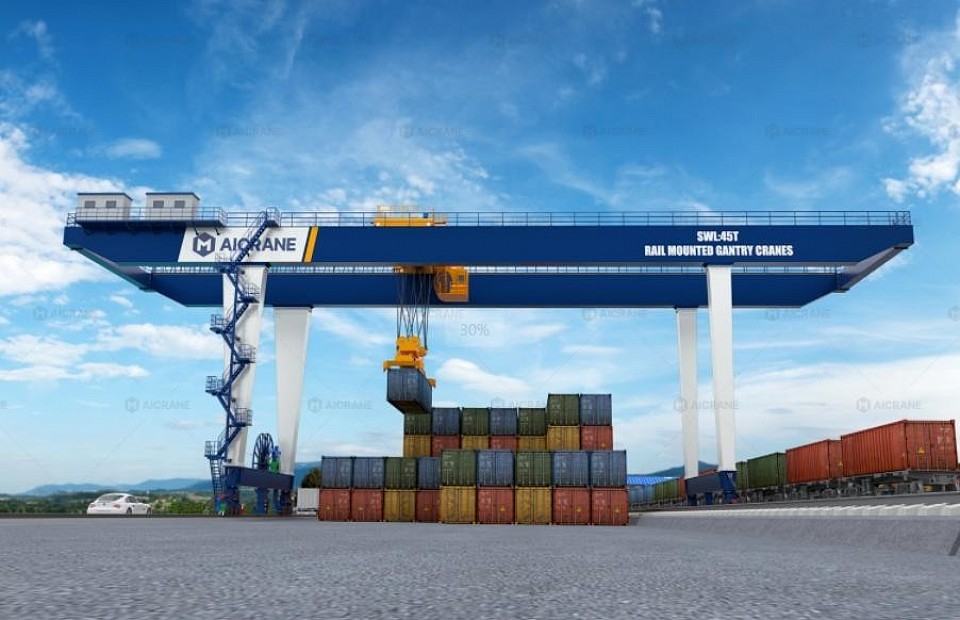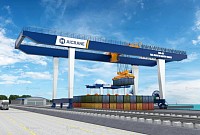Rail Mounted Gantry (RMG) cranes play a critical role in container terminals, rail yards, and intermodal facilities by handling containers efficiently and precisely. As global logistics become increasingly complex and containerized transport more diverse, customizing RMG cranes to handle specific container sizes is not only beneficial - it's essential for optimizing throughput, safety, and operational flexibility. This article explores the key factors, steps, and technologies involved in customizing RMG cranes for different container sizes, including 20ft, 40ft, 45ft, and beyond.
Understanding Standard Container Sizes
Before diving into customization, it’s important to understand the common container sizes in global logistics. The International Organization for Standardization (ISO) has defined the most common types:
20-foot container (TEU): 6.06m x 2.44m x 2.59m
40-foot container (FEU): 12.2m x 2.44m x 2.59m
40-foot High Cube container: 12.2m x 2.44m x 2.90m
45-foot High Cube container: 13.7m x 2.44m x 2.90m
Special containers such as refrigerated containers, tank containers, and flat racks may have different dimensions and handling needs.
Customizing rail mounted gantry cranes to handle these variations ensures operational efficiency, minimizes damage risk, and maximizes throughput.
Why Customization Matters
1. Improved Efficiency
Each container size requires different lifting positions and spreader configurations. A well-customized RMG crane can quickly adapt to size changes without time-consuming manual adjustments.
2. Enhanced Safety
Customizations such as automated size detection and container locking mechanisms reduce human error, minimizing accidents and cargo damage.
3. Adaptability for Mixed Handling
In yards where multiple container types are handled daily, flexibility in crane operation becomes a strategic advantage.
4. Cost Optimization
Efficient handling leads to faster turnaround times and less idle time for equipment, which translates to lower operational costs.
Key Customization Parameters
1. Spreader Design and Adjustment Mechanism
The spreader is the most crucial component in container size handling. Customization includes:
Telescopic Spreaders: These can extend or retract to accommodate 20ft, 40ft, and 45ft containers.
Automatic Position Adjustment: Motorized systems adjust the spreader length and lock positions automatically based on container type.
Twin-Lift Capability: For terminals requiring high throughput, twin-lift spreaders can lift two 20ft containers simultaneously.
2. Crane Span and Rail Gauge
While the rail gauge is typically fixed according to the yard design, the crane span must accommodate stacking containers across multiple tracks and lanes. The customization may include:
Wider spans for multiple rail lines or truck lanes
Higher stacking heights to accommodate container stacks of different sizes and weights
3. Hoisting and Trolley Systems
Lifting mechanisms must support the weight of the largest containers, including fully loaded 45ft high cubes. This requires:
Adequate lifting capacity (typically ranging from 30 to 50 tons or more)
Fast hoisting speeds with variable frequency drives (VFDs)
Anti-sway systems to maintain precise container placement
4. Automation and Smart Control
Intelligent systems enhance crane versatility and minimize downtime:
Container recognition systems using RFID or vision technology
Yard management system integration to automatically select the correct spreader size
Automated positioning and alignment for faster cycle times
Step-by-Step Customization Process Step
1: Identify Container Mix and Yard Layout
Start by evaluating the container types most frequently handled. Will your terminal primarily deal with 20ft and 40ft containers, or are 45ft and specialty containers common? Also assess:
Rail lane configurations
Truck lanes and loading points
Stacking heights and density requirements
Step 2: Define Crane Specifications
Based on the above data, define:
Lifting capacity (e.g., 40–50 tons)
Span and lifting height (e.g., 32m span, 12m lifting height)
Required work duty (e.g., A5–A8 based on operating hours)
Hoisting speed and trolley travel speed
Step 3: Select or Design the Spreader
Customize or select a telescopic spreader suitable for the anticipated range of container sizes. Consider:
Twistlock system type
Extension and retraction speed
Rotation and alignment mechanisms
Step 4: Integrate Control and Detection Systems
Include intelligent systems for:
Container size detection
Automatic spreader adjustment
Collision avoidance
Remote diagnostics and performance monitoring
Step 5: Adapt Mechanical Structure
Ensure the crane structure - including girder design, trolley rail placement, and spreader carrier - accommodates the necessary movements for handling varying container lengths.
Step 6: Test and Commission
During factory acceptance testing and on-site commissioning:
Simulate container handling scenarios with different sizes
Calibrate sensors, software, and controls
Train operators on mixed-load operations
Case Example: RMG Crane for Mixed Container Handling
A logistics operator in Central Asia needed a solution for a container yard adjacent to a railway terminal. They required an RMG container gantry crane that could handle:
20ft, 40ft, and 45ft containers
Daily handling of over 100 containers
Harsh weather conditions with wind and snow
Solution Highlights:
Customized RMG crane with a 32m span and 12.5m lifting height
Telescopic twin-lift spreader with automatic locking
Work duty A6 for intensive operations
Integrated yard management system
Anti-sway system and automatic container positioning
This customization allowed for fast switching between container sizes, reduced human error, and significantly improved throughput.
Tips for Choosing the Right RMG Customization Partner
Experience Matters: Choose a supplier with proven experience in container crane customization.
Turnkey Solutions: Opt for manufacturers that offer design, fabrication, testing, delivery, and installation services.
After-Sales Support: Look for providers offering spare parts, maintenance, and operator training.
Digital Integration: Ensure compatibility with your terminal’s software and digital infrastructure.
Conclusion
Customizing RMG cranes for specific container sizes is no longer a luxury but a necessity for modern logistics hubs. Whether handling standard ISO containers or accommodating a variety of containerized cargo, the right customizations - from spreader design to smart automation - ensure operational excellence, safety, and long-term cost savings.
At Aicrane, we specialize in tailor-made RMG crane solutions for rail terminals, ports, and logistics facilities. From detailed consultations to final installation, our engineering team ensures your crane is perfectly adapted to your handling needs - now and in the future.


